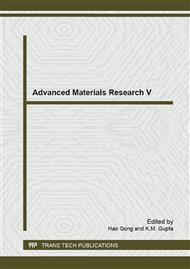[1]
N.S. Suharty, I.P. Almanar, Sudirman, K. Dihardjo, N. Astasari. Flammability, Biodegradability dan Mechanical Properties of Bio-Composites Waste Polypropilene /Kenaf Fiber Containing Nano CaCO3 with Diammonium Phosphate, Procedia Chemistry, 4, (2012).
DOI: 10.1016/j.proche.2012.06.039
Google Scholar
[2]
M. Sarkar, K. Dana, S. Ghatak, and A. Banerjee. Polypropylene-Clay Composite Prepared from Indian Bentonite, B. Mater. Sci., 31(1), (2008) 23-28.
DOI: 10.1007/s12034-008-0005-5
Google Scholar
[3]
N.S. Suharty, B. Wirjosentono, M. Firdaus, D.S. Handayani, J. Sholikhah, Y.A. Maharani. Synthesis of degradable bio-composites based on recycle polypropylene filled with bamboo powder using a reactive process, J. Phys. Sci., 19, (2008) 105–115.
Google Scholar
[4]
M. Sain, J. Balatinecz, S. Law. Creep fatigue in engineered wood fibres and plastic compositions. J Appl. Polym. Sci., 77, (2000) 260.
DOI: 10.1002/(sici)1097-4628(20000711)77:2<260::aid-app3>3.0.co;2-h
Google Scholar
[5]
A.K. Bledzki, A.A. Mamun, O. Faruk. Abaca Fibre Reinforced PP Composites and Comparison with Jute and Flax Fibre PP Composites. eXPRESS Polymer Letter, 1(11), (2007) 755-762.
DOI: 10.3144/expresspolymlett.2007.104
Google Scholar
[6]
G.S. Olivares, A.S. Solis, and O. Manero. Burning Rate, Mechanical and Rheological Properties of HIPS-PET and Clay Nanocomposites. Int. J. Polym. Mater., 57, (2008) 417-428.
DOI: 10.1080/00914030701729180
Google Scholar
[7]
M. Sain, S.H. Park, F. Suhara, S. Law. Flame retardant and mechanical properties of natural fiber–PP composites containing magnesium hydroxide, Poly. Deg. and Stab. 83: (2004) 363–367.
DOI: 10.1016/s0141-3910(03)00280-5
Google Scholar
[8]
H.S. Yang, H.J. Kim, H.J. Park, B.J. Lee, T.S. Hwang. Effect of compatibilizing agents on rice-husk flour reinforced polypropylenecomposites. Compos. Struct., 77, (2007) 45–55.
DOI: 10.1016/j.compstruct.2005.06.005
Google Scholar
[9]
E. Moncada, R. Quijada, I. Lieberwirth, and M. Yazdani-Pedram. Use of PP Grafted with Itaconic Acid as a New Compatibilizer for PP/Clay Nanocomposites. Macromol. Chem. Physic, 207, (2006) 1376–1386.
DOI: 10.1002/macp.200600150
Google Scholar
[10]
P.K. Patra, S.B. Warner, Y.K. Kim, Q. Fan, P.D. Calvert, S. Adanur. Nano Engineered Fire Resistant Composite Fibre, NTC Annual Report. No: M02-MD08, (2005) 1-10.
Google Scholar
[11]
G. Tesoro, Chemical Modification of Polymers with Flame-Retardant Compounds. J. Polym. Sci. Macromol. Rev., 13, (1978) 283-353.
DOI: 10.1002/pol.1978.230130106
Google Scholar
[12]
Z. Al Hassany, A. Genovese, R.A. Shanks. Fire Retardant and Fire-barrier Poly(vinyl acetate) Composites for Sealant Application. Journal of Polymer Letters, 4, (2010) 70-93.
DOI: 10.3144/expresspolymlett.2010.13
Google Scholar
[13]
P. Pasbakhsh, H. Ismail, M.N. Ahmad Fauzi and A. Abu Bakar. Influence of Maleic Anhydride Grafted Ethylene Propylene Diene Monomer (MAH-g-EPDM) on the Properties of EPDM Nanocomposites Reinforced by Halloysite Nanotubes. Polym. Test, 28, (2009).
DOI: 10.1016/j.polymertesting.2009.04.004
Google Scholar
[14]
N.S. Suharty, I. Hanafi, K. Diharjo, M. Nizam, M. Firdaus. Improvement of Inflam-mability and Biodegradability of Bio-composites Using Recycled Polypropylene with Kenaf Fiber Containing Mixture Fire Retardant, Advanced Materials Research Journal, 950, (2014).
DOI: 10.4028/www.scientific.net/amr.950.18
Google Scholar
[15]
B.R. Ilic, A.A. Mitrovic and L.R. Ljiljana. Thermal Treatment of Kaolin Clay to Obtain Metakaolin. Hem. Ind., 64(4), (2010) 351-356.
DOI: 10.2298/hemind100322014i
Google Scholar
[16]
J. Pascual, E. Fages, O. Fenollar, D. García, and R. Balart. Influence of The Compatibilizer/Nanoclay Ratio On Final Properties of Polypropylene Matrix Modified with Montmorillonite-Based Organoclay. Polym. Bull. No. 62, (2008) 367-380.
DOI: 10.1007/s00289-008-0018-7
Google Scholar
[17]
T.P. Mohan, M.R. Kumar, R. Velmurugan. Mechanical and Barrier Properties of Epoxy Polymer Filled with Nanolayered Silicate Clay Particles, J. Mater. Sci., 41, (2006) 2929-2937.
DOI: 10.1007/s10853-006-5164-4
Google Scholar
[18]
Kusmono, Z.A.M. Ishak, W.S. Chow, T. Takaechi and Rochmadi. Enhancement of Properties of PA6/PP Nanocomposites Via Organic Modification and Compatibilization, eXPRESS Polymer Letter, 2 (9), (2008) 655-664.
DOI: 10.3144/expresspolymlett.2008.78
Google Scholar
[19]
M.A. HaiYun, S. PingAn and F. ZhengPing. Flame Retardant Polymer Nano- composites: Development, Trend and Future Perspective. Sci. China. Chem. 41(2), (2011) 314-327.
Google Scholar


